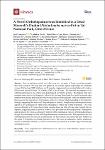A Novel Orthohepadnavirus Identified in a Dead Maxwell’s Duiker (Philantomba maxwellii) in Taï National Park, Côte d’Ivoire
Gogarten, Jan F.
Ulrich, Markus
Bhuva, Nishit
Garcia, Joel
Jain, Komal
Lee, Bohyun
Löhrich, Therese
Oleynik, Alexandra
Couacy-Hymann, Emmanuel
Fuh Neba, Terence
Mishra, Nischay
Briese, Thomas
Calvignac-Spencer, Sébastien
Lipkin, W. Ian
Leendertz, Fabian H.
New technologies enable viral discovery in a diversity of hosts, providing insights into viral evolution. We used one such approach, the virome capture sequencing for vertebrate viruses (VirCapSeq-VERT) platform, on 21 samples originating from six dead Maxwell’s duikers (Philantomba maxwellii) from Taï National Park, Côte d’Ivoire. We detected the presence of an orthohepadnavirus in one animal and characterized its 3128 bp genome. The highest viral copy numbers were detected in the spleen, followed by the lung, blood, and liver, with the lowest copy numbers in the kidney and heart; the virus was not detected in the jejunum. Viral copy numbers in the blood were in the range known from humans with active chronic infections leading to liver histolytic damage, suggesting this virus could be pathogenic in duikers, though many orthohepadnaviruses appear to be apathogenic in other hosts, precluding a formal test of this hypothesis. The virus was not detected in 29 other dead duiker samples from the Côte d’Ivoire and Central African Republic, suggesting either a spillover event or a low prevalence in these populations. Phylogenetic analysis placed the virus as a divergent member of the mammalian clade of orthohepadnaviruses, though its relationship to other orthohepadnaviruses remains uncertain. This represents the first orthohepadnavirus described in an artiodactyl. We have tentatively named this new member of the genus Orthohepadnavirus (family Hepadnaviridae), Taï Forest hepadnavirus. Further studies are needed to determine whether it, or some close relatives, are present in a broader range of artiodactyls, including livestock.
Dateien zu dieser Publikation

